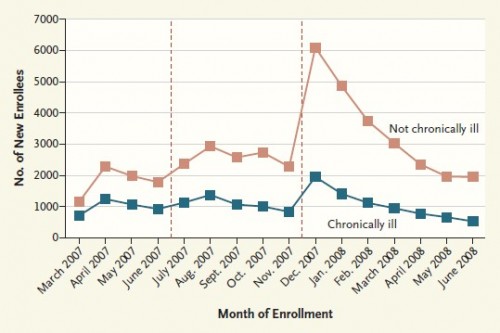The purpose of the individual mandate is to keep adverse selection below levels that would destabilize the insurance market. I made this point before, citing a state report that concluded that adverse selection is very low in Massachusetts. In a new paper NEJM paper, Amitabh Chandra, Jonathan Gruber, and Robin McKnight provide evidence consistent with that conclusion.
In the following figure, the leftmost vertical dashed line represents when insurance subsidies became available in Massachusetts. The rightmost dashed line represents the start of the period when the mandate became fully operational.
The authors write,
We therefore examined the behavior of Massachusetts residents with incomes between 150 and 300% of the poverty level, who were eligible for subsidies and had to pay insurance premiums that were meaningful but much smaller than those mandated by the ACA.
Using claims data from the Massachusetts Commonwealth Connector, we measured the health mix of the population enrolling in Commonwealth Care. […]
[As shown in the figure a]t the beginning of the mandate’s phase-in in mid-2007, there was a greater increase in the number of healthy enrollees than in the number of enrollees with chronic illness. When the mandate became fully effective at the end of 2007, there was an enormous increase in the number of healthy enrollees and a far smaller bump in the enrollment of people with chronic illness. The gap then shrank to premandate levels as the remaining uninsured residents complied with the mandate, but clearly the mandate brought many more healthy people than nonhealthy ones into the risk pool. The large jump in healthy enrollees that occurred when the program became fully effective suggests that enrollment by the healthy was not simply slower than enrollment by the unhealthy, but rather that the mandate had a causal role in improving risk selection.
That huge jump in enrollment of healthier individuals, relative to the chronically ill, when the fully mandate kicked in is the effect of the mandate. It isn’t due to subsidies, as they existed prior to the fully phased-in mandate date. Consequently, the mandate had a large, causal, and favorable selection effect on the insured risk pool. That is, the mandate did the job it was designed to do.



